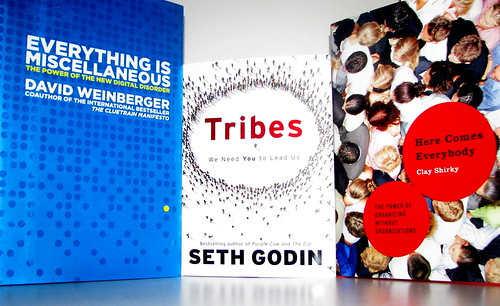I usually review one book at a time in this blog. Not today. These three excellent books go so well together that I can’t help sharing them all at once.  Each one examines an aspect of the web 2.0* social networking revolution (and the technology supporting it), and then projects into a not-too-distant future. That future, in fact, may already be here.
Each one examines an aspect of the web 2.0* social networking revolution (and the technology supporting it), and then projects into a not-too-distant future. That future, in fact, may already be here.
Reading any of these books would be rewarding, but I recommend devouring all three in the same order I read them this year. Each one leads smoothly into the next. Together, they describe the change that is profoundly reorganizing the social, political, and business world as we know it.
1. TECHNOLOGY REVOLUTION
Published in 2007, Everything is Miscellaneous [LibraryThing / WorldCat] by David Weinberger introduces us to the changes digital technology has brought to information organization and retrieval. Sounds geeky, right? Not at all. Weinberger uses the very understandable example of a photo archive to explain how storing, cataloging, and finding a particular photo has gone from an expensive, laborious process accessible to very few people, to an inexpensive, easy, real-time activity open to anyone.
Web 2.0 technology liberates us from dealing solely with atoms (“real” things) and opens new possibilities using bits (information about the things). A real object can only exist in one place, so it must be precisely placed if we hope to find it again. Data about an object gives us a bit more freedom to make the object retrievable through several different routes. With data (and metadata**) built on web 2.0 platforms like Flickr and LibraryThing, cumbersome cataloging and organization schemes — and those precise placement requirements of the past — can be pushed aside. Everything is miscellaneous now. Everything can be sorted, rearranged, tagged, toyed with, shared, mashed, and discovered all over again. Weinberger’s book is filled with examples and stories that illustrate our new tools and the radically new perspectives they engender. Digital technology makes them possible; the volume and pace of which new information is created makes them necessary; and the value of their collaborative results make it preferable.
2. SOCIAL NETWORKING REVOLUTION
Here Comes Everybody by Clay Shirky [LibraryThing / WorldCat], carries Weinberger’s argument further into the social realm. We have this amazing new technology at our fingertips. Now what? Shirky shows how people are collaborating and harnessing its power. The ease of online publishing combined with the power of social networking creates possibilities previously unimagined. A participant on the social web can connect to others with common interests and make things happen — sometimes very quickly. Or instantly! Like Weinberger, Shirky fills his book with examples pulled from real life. His first example — that of woman who left her cell phone in a New York cab — is a fascinating tale involving hundreds of strangers reacting and mobilizing. It’s a precursor to other examples in the book. Shirky’s message is that collaboration is a powerful tool, that it has become much easier to tap into, and that it should not — cannot — be ignored any longer. If someone has a purpose (or a message, or a complaint, or an idea), and he or she publishes it, other people will likely identify with it and join in. Here comes everybody.
3. LEADERSHIP REVOLUTION.
After Weinberger and Shirky explore the new technology and social power available, Seth Godin’s book Tribes [LibraryThing / WorldCat] discusses how people within a social network (or tribe) organize themselves. He begins with the premise that we already belong to tribes: family, corporate, social, and political, to name a few. Web 2.0 technology permits us to join even more communities without geographic restraint.
Tribes organize around common ideas. Some members lead, some add their voice, and some simply add to the numbers. In a world where change is inevitable and the status quo gets pushed aside, Godin encourages leadership. Anyone can lead. You need not be a CEO or a manager to lead a movement. In fact, a person burdened with official authority might find it difficult to lead a tribe in the direction it ought to go. Managers, therefore, should welcome leaders from wherever within the organization they emerge. Leaders show vision and motivation. They offer ideas for a better widget or process. They show the way, even if that way is not business as usual. Tribes will follow, change, or find new leaders.
Tribes is a much shorter book than the other two. Godin wrote it in brief talking points — as if he dictated the book through Twitter. It’s a different style, but no less meaningful. I found Shirky’s book to be the most enjoyable, but all three books are insightful.
THREE MORE BOOKS.
A few earlier books could easily fit into this mix: The Long Tail by Chris Anderson [LibraryThing / WorldCat], The Wisdom of Crowds by James Surowiecki [LibraryThing / WorldCat and previously reviewed here]; and Wikinomics by Don Tapscott and Anthony Williams [LibraryThing / WorldCat]. I recommend them, too.
—-

